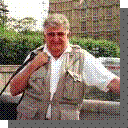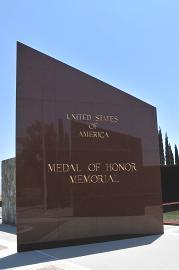
|
Vol.2, No. 12, July 2009 |

|
If you are having problems viewing this page or the graphics please Click Here to view it in your browser or to visit our Blog Click Here. To view my Galleries of Geo-referenced photos from around the world Click Here. To view additional galleries Click Here. |
|
To remove your name from our mailing list, please click here. Questions or comments? Email us at fhenstridge@henstridgephotography.com or call 951-679-3530 To view as a Web Page Click Here. Please visit our Web Site at http://henstridgephotography.com. © 2009 Fred Henstridge Photography All Photos, Images, Graphics and Text are the copyright of Fred Henstridge Photography. All Rights are Reserved. |
|
Medal of Honor Memorial at the Riverside National Cemetery |
|
Medal of Honor Memorial at the Riverside National Cemetery |
|
Present day variations of the Medal of Honor |
|
Latest Medal of Honor recipients including Gary Gordon. Randall Shughart and Michael Monsoor |
|
Looking northerly along LeMay Blvd. from the Memorial |
|
Looking southerly past the Memorial fountain |
|
Memorial to the Third Infantry Division on LeMay Blvd. |

|
Since its inception in 1861 there have been 3,447 Medals of Honor (often called the Congressional Medal of Honor) awarded, of which 19 were double recipients, for exceptional valor and conspicuous gallantry in the course of military service to the country. All 3,447 names are engraved with gold lettering on a red marble wall at the Medal of Honor Memorial in a corner of the Riverside National Cemetery in Riverside, California. Dedicated in 1999, the Riverside Medal of Honor Memorial is one of four sites, in the United States, recognized as a National Medal of Honor Memorial.
I had heard of the MOH Memorial so Kathy and I paid a visit to the Riverside National Cemetery last week. I can’t begin to note the many times I have passed the entrance to cemetery on the way to my son’s house. He lives about a mile away just off Van Buren Blvd. The cemetery is located on Van Buren Boulevard about one half mile west of the I-215 and the entrance to March Field Air Reserve Base. There is a large stone sign at the entrance, you can’t miss it.
Riverside National Cemetery is the third-largest cemetery managed by the National Cemetery Administration, and since 2000 has been the most active in the system based on the number of interments. It was established in 1976 through the transfer of 740 acres from March Air Force Base. The cemetery was dedicated and opened for burials Nov. 11, 1978. An additional 181 acres was transferred by the Air Force in 2003. The dramatic, meandering landscape features a central boulevard (LeMay Blvd.) with memorial circles, lakes, indigenous-styled committal shelters, and the Medal of Honor Memorial. |

|
While we were touring the cemetery there were three interments in progress. Each funeral had a military guard of honor and one had those famous motorcycle riders in attendance. There must have been over 50 Harleys, Hondas and Kawasakis parked along the road adjacent to the ceremony.
There are many notables interred at the cemetery. If you stop by the guard house at the entrance the guard can point you to some of these grave sites and perhaps give you a map of the cemetery. A few of the notables include.
· Lt. J.G. Robert Edward Badham, U.S. Navy and Congressman from California. · Tech Sgt. George Baker, U.S. Army World War II cartoonist. Baker was a former Disney cartoonist who created the comic strip and comic book character "The Sad Sack,” during World War II. · Colonel Aaron Bank, U.S. Army, Founder of the Army’s elite Green Berets. · Yeoman First Class Melissa Rose Barnes, U.S. Navy. She was killed during the terrorist attack on the Pentagon, Sept. 11, 2001. · Staff Sgt. John D. McKeel, Jr., U.S. Marine Corps. One of the 52 Americans held hostage by Iran from 1979 to 1981. Shot to death while trying to help a woman who was being robbed. · Captain Lillian Kinkela Keil, U.S. Air Force. Air Force Flight Nurse Pioneer, she flew on 425 combat missions and took part in 11 major campaigns that included the D-Day invasion and Battle of the Bulge in World War II and the Battle of the Chosin Reservoir during the Korea War. One of the most decorated women in American military history, she was awarded 19 medals, including a European Theater medal with four battle stars, a Korean service medal with seven battle stars, four air medals and a Presidential Citation from the Republic of Korea. · Patrick Henry McMahon, Motor Machinist Mate First Class, U.S. Navy. During World War II, McMahon was rescued near the Solomon Islands from the wreckage of patrol boat PT-109 by Lt. John F. Kennedy. The boat had been rammed by a Japanese destroyer on August 2, 1943. Badly injured and burned, McMahon was towed for several miles to safety by the future U.S. president. · Woodrow "Woody" Strode, Section 46, Grave 283. Woody Strode starred as 1st Sergeant Braxton Rutledge, a Buffalo soldier, in the 1960 John Ford movie "Sergeant Rutledge.” He starred in over 80 domestic and foreign films in a career that spanned nearly 55 years. Strode was also one of the first four blacks to integrate Major League football in 1946 when he played for the Cleveland Rams, and · Seven Tuskegee Airmen are buried at Riverside National Cemetery |

|
The Medal of Honor is the highest award for valor in action against an enemy force which can be bestowed upon an individual serving in the Armed Services of the United States. Generally presented to its recipient by the President of the United States of America in the name of Congress, it is often called the Congressional Medal of Honor.
On December 9, 1861 Iowa Senator James W. Grimes introduced SB. No. 82 in the United States Senate, a bill designed to "promote the efficiency of the Navy" by authorizing the production and distribution of "medals of honor". On December 21st the bill was passed, authorizing 200 such medals be produced "which shall be bestowed upon such petty officers, seamen, landsmen and marines as shall distinguish themselves by their gallantry in action and other seamanlike qualities during the present war (Civil War)." President Lincoln signed the bill and the (Navy) Medal of Honor was born.
Soon afterwards the Army followed suite and eventually all military personnel, including spies would be eligible for the Medal. On February 13, 1861 Army Assistant Surgeon Bernard J.D. Irwin rescued 60 soldiers of 2nd Lieutenant George Bascom's unit at Apache Pass, AZ. Though the Medal of Honor had not yet been proposed in Congress (and actually wouldn't even be presented to Irwin until 1894), it was the first heroic act for which the Medal of Honor would be awarded). On May 24, 1861, in Alexandria, VA Army Private Francis Edwin Brownell performed the first action of the Civil War to merit the Medal of Honor.
During the Civil War there were 1,520 Medals of Honor awarded including: 11 for actions at the first battle of Manassas (Bull Run), 20 for Antietam, 19, at Fredericksburg, 96 for Vicksburg, 52 at Petersburg, and 58 at Gettysburg. Other actions where the Medal was awarded are: 24 for actions at the Little Big Horn (1876), 109 sailors and Marines aboard the Battleship Maine in Manila Harbor (Feb 15,1898), and 29 for the Boxer Rebellion (June 20, 1900). On May 3, 1919 Sergeant Alvin C. York was awarded the MOH six months after the end of WWI. This would mark a milestone in the history of the Medal. It and its recipients would now be made celebrities by the press and films.
Only one Coastguardsman was ever awarded the Medal. Canadian born Douglas Munro received the Medal for his actions on Guadalcanal on September 27, 1942. For all of their heroic actions in World War II Japanese-Americans fighting with the 442nd Infantry Regiment received only Medal. PFC Sadao S. Munemori became the only Japanese-American of the war to earn his Nation's highest honor. His Medal of Honor, presented posthumously to his mother, is on display at the Smithsonian Institution in Washington, D.C. |



|
It is an awe-inspiring experience to walk through the Memorial and ponder on some of the engraved names realizing that each name has a story attached to it. That story is the citation that goes with the Medal. One of the latest recipients is Mater-at Arms, Michael Monsoor, a Navy SEAL. He received his Medal for actions in Ramadi, Iraq. His citation reads thusly: “For conspicuous gallantry and intrepidity at the risk of his life above and beyond the call of duty as automatic weapons gunner for Naval Special Warfare Task Group Arabian Peninsula, in support of Operation IRAQI FREEDOM on 29 September 2006. As a member of a combined SEAL and Iraqi Army Sniper Overwatch Element, tasked with providing early warning and stand-off protection from a rooftop in an insurgent held sector of Ar Ramadi, Iraq, Petty Officer Monsoor distinguished himself by his exceptional bravery in the face of grave danger. In the early morning, insurgents prepared to execute a coordinated attack by reconnoitering the area around the element’s position. Element snipers thwarted the enemy’s initial attempt by eliminating two insurgents. The enemy continued to assault the element, engaging them with a rocket-propelled grenade and small arms fire. As enemy activity increased, Petty Officer Monsoor took position with his machine gun between two teammates on an outcropping of the roof. While the SEALs vigilantly watched for enemy activity, an insurgent threw a hand grenade from an unseen location, which bounced off Petty Officer Monsoor’s chest and landed in front of him. Although only he could have escaped the blast, Petty Officer Monsoor chose instead to protect his teammates. Instantly and without regard for his own safety, he threw himself onto the grenade to absorb the force of the explosion with his body, saving the lives of his two teammates. By his undaunted courage, fighting spirit, and unwavering devotion to duty in the face of certain death, Petty Officer Monsoor gallantly gave his life for his country, thereby reflecting great credit upon himself and upholding the highest traditions of the United States Naval Service.”
There are many other such stories like the heroic actions of Delta Force snipers Gary Gordon and Randall Shughart for their actions in Somalia, made famous in the film “Black Hawk Down” and the most recent recipient Ross A. McGinnis. You can read more about the Medal on the Official Congressional Medal of Honor Society web site. For a complete galley of photos from the Memorial and Cemetery please click here.
If you are planning a visit to the March Air Field Museum take an extra hour or so to pay a visit to the Medal of Honor Memorial at the Riverside National Cemetery and pay honor to those who sacrificed so much for this country. |

